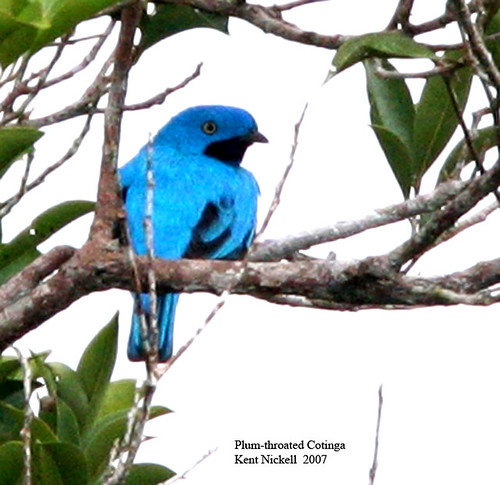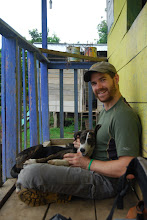Several years ago while still studying at Bucknell, one day I checked a science news website to read “New Bird Species Found!” Following the link, I learned how a previously known species had just been discovered in Belize, where it had never been seen before. As a picture of the bird popped up next to the article everything else melted away for a few moments, as I stared motionlessly at an electric blue bird with a deep purple throat and a doll-like yellow eye that seemed to stare vacuously at me from the webpage. Learning that discoveries like this were still occurring in the world began to revive my childhood dreams of visiting South America to behold such exuberant examples of beauty for myself. I showed this photo to many people, and eventually the image crept into the deeper folds of my mind. I found myself taking leave from my class conversations to daydream about trudging through a dense and steamy jungle someday, to hopefully look up one day and see this bird standing before me.
Since receiving the newest field guide on the birds of Peru for Christmas, I often flipped to the page where this cotinga stood staring back at me. I would stare at the bird for long periods of time, lost in its beauty, as if just to stare at it might give me some premonition, some calling as to where I could find it waiting in the forest.
---
Searching for birds is not much different than the pursuit of some coveted love affair. If I was a woman, I would be forever skeptical of a ‘birder’. One needs only to sit around them for a few minutes before their painfully obvious obsession with beauty becomes apparent. While the type of man undoubtedly varies across many spectrums of creepiness, pretentious-ness, and other similar adjectives, all of these men have this weak obsession for beauty in common. For many of these men, I believe this obsession for birds is a reaction, as well as a coping mechanism, to horribly failed relationships in which love was mistaken for obsession and acquisition of beauty.
While I find myself falling somewhere in the midst of this category, I feel in the end it is how you appreciate an object for what it is, not what status it holds in your mind. Beneath a dress, they may seem like the most beautiful breasts, but when the dress is finally slumped against the wall in a pile on the floor, you are still just looking at breasts. The same holds true for birds. Beauty is in the eye of the beholder. That is all.
However, despite this realization, I unwittingly felt such youthful aspirations seeping back into my mind, and I was awash in my teenage self. As I let the promise of this bird’s beauty lull me into obsession, I was once again balancing on the line separating reality and covetous delusion.
---
While out on a walk looking for birds today by myself, I stopped in a sunny clearing where a bamboo-like plant called carrizo grows tall. Amidst this field of carrizo, a few old trees stand alone beneath the blazing sun. Hearing a woodpecker tapping away, I began to randomly scan one of these trees in search of it. I followed the trunk of the tree up to its shady canopy, and suddenly there was a burst of electric blue in my binoculars. My mouth dropped wide open. Sitting motionlessly, its bright yellow eye shining back at me eerily; there was the Plum-Throated Cotinga.
 And so, there it was, a bird I have been dreaming about seeing for three years. I looked around, as if someone should suddenly have appeared for me to high five. Clinging to the projected meaning of this moment, I let out a little yell, did a little booty dance on the trail, seriously I did, and then looked through my binoculars again. In doing this, I was reminded of what it now meant for me to check off a dream on the list.
And so, there it was, a bird I have been dreaming about seeing for three years. I looked around, as if someone should suddenly have appeared for me to high five. Clinging to the projected meaning of this moment, I let out a little yell, did a little booty dance on the trail, seriously I did, and then looked through my binoculars again. In doing this, I was reminded of what it now meant for me to check off a dream on the list. Seeing this bird doesn’t necessarily make this day or this six-month trip any more special than it would have been without it, but it symbolizes the culmination of a dream that has lived in me for a long time. When dreams become reality, it is easy fool yourself into sentimentally clinging to the moment, as if you can remain crystallized in its revelry, but from such sentimentality often comes a skewed and painful understanding of reality. The challenge in realizing a dream come true is in treating it as you would any other moment of your life. Each moment has its clear meaning, which does not vary from one to the next.
In this way, I feel I am learning how to navigate my life through a matrix of dreams. While each dream I find shining in the night sky may tell me I am on the right path, the night would be rather dark and lonely without all the other stars in the sky. So, while realizing my dreams gives me bearing on which to set course for future dreams, I try to seek out and enjoy the light that each moment shines on me. And with some time and diligent, concerted effort, I may slowly learn how to perceive the reality of each moment as a dream come true. Until then, I at least know I am on the right path.
















